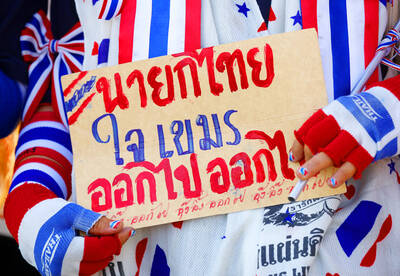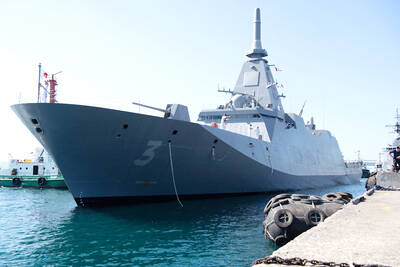Red, white and gold balls of light shimmered low on the horizon off Havana’s seafront Malecon Boulevard on Saturday night in a maritime fireworks display launched by Cuban exiles hoping to inspire protest.
The fireworks were clearly visible from the coast and lasted about an hour. People who saw it said they were mystified by its origin.
“It’s curious, because you don’t see that often on the Malecon,” said Jose Antonio Camejo, who was fishing for red snapper from the seawall along with family members.
Told it was organized by Cuban exiles from Florida, he shrugged and said, “They must be celebrating something.”
The small Florida non-profit group the Democracy Movement said earlier that they would park their vessels 20km from Havana, safely outside the 19km territorial water limits.
The exiles timed the show to coincide with a summer carnival that can draw thousands to the Malecon, and they called the show a peaceful display of solidarity with their compatriots.
“When you see the lights of freedom, walk toward the seawall as a silent protest against censorship of expression,” said the Democracy Movement’s Ramon Saul Sanchez. “And when you’re there, among the people, think of freedom, murmur ‘freedom’ and if you deem it prudent, demand freedom.”
Cuban authorities scaled back the carnival festivities after torrential rains soaked Havana on Saturday. Several hundred people still came out to enjoy the celebration on the seawall, yet, like similar previous displays, the fireworks did not elicit any discernible protest from Havana residents.
However, the shows are an irritation for the Cuban Communist government, which considers them provocative, subversive and potentially dangerous. Cuban officials did not respond to requests for comment, but have criticized Washington in the past for not blocking the actions.
In 1996, the Cuban military shot down two small planes carrying exile activists, killing four people. Cuba maintains the aircraft violated the country’s airspace, though the exiles deny that.
Sanchez said he had been in contact with the US Coast Guard, which has patrolled previous sea missions to guard against an international incident, and given assurances that they would remain outside the 19km maritime limit.
US officials have said they do not encourage such activities, but lack legal authority to block them.
Sanchez said a second message behind the display was to demand greater Internet access on the island, which lags the rest of the world despite the completion of an undersea fiber-optic cable last year.
“The Cuban government has just installed the cable from Venezuela that allows 3,000 times more technical capability of connection and yet it has not translated into benefits for the Cuban people in terms of access,” he said.
Cuba blames its creaky Internet on Washington’s 50-year-old economic embargo.
Sanchez said his group has organized 26 flotillas since 1996, including a similar fireworks show last December to mark International Human Rights Day, and another one in March when Pope Benedict XVI visited the island.
Sanchez said the group does not accept any government money and holds fundraisers to finance its activities. A sympathetic provider let the group purchase the fireworks at cost, which came out to US$3,600. The other main expense was fuel.
He said the lead vessel alone, dubbed “Democracia,” was expected to consume more than US$2,100 in gasoline to make the return trip across the 144km Florida Strait.

Eleven people, including a former minister, were arrested in Serbia on Friday over a train station disaster in which 16 people died. The concrete canopy of the newly renovated station in the northern city of Novi Sad collapsed on Nov. 1, 2024 in a disaster widely blamed on corruption and poor oversight. It sparked a wave of student-led protests and led to the resignation of then-Serbian prime minister Milos Vucevic and the fall of his government. The public prosecutor’s office in Novi Sad opened an investigation into the accident and deaths. In February, the public prosecutor’s office for organized crime opened another probe into

RISING RACISM: A Japanese group called on China to assure safety in the country, while the Chinese embassy in Tokyo urged action against a ‘surge in xenophobia’ A Japanese woman living in China was attacked and injured by a man in a subway station in Suzhou, China, Japanese media said, hours after two Chinese men were seriously injured in violence in Tokyo. The attacks on Thursday raised concern about xenophobic sentiment in China and Japan that have been blamed for assaults in both countries. It was the third attack involving Japanese living in China since last year. In the two previous cases in China, Chinese authorities have insisted they were isolated incidents. Japanese broadcaster NHK did not identify the woman injured in Suzhou by name, but, citing the Japanese

YELLOW SHIRTS: Many protesters were associated with pro-royalist groups that had previously supported the ouster of Paetongtarn’s father, Thaksin, in 2006 Protesters rallied on Saturday in the Thai capital to demand the resignation of court-suspended Thai Prime Minister Paetongtarn Shinawatra and in support of the armed forces following a violent border dispute with Cambodia that killed more than three dozen people and displaced more than 260,000. Gathered at Bangkok’s Victory Monument despite soaring temperatures, many sang patriotic songs and listened to speeches denouncing Paetongtarn and her father, former Thai prime minister Thaksin Shinawatra, and voiced their backing of the country’s army, which has always retained substantial power in the Southeast Asian country. Police said there were about 2,000 protesters by mid-afternoon, although

MOGAMI-CLASS FRIGATES: The deal is a ‘big step toward elevating national security cooperation with Australia, which is our special strategic partner,’ a Japanese official said Australia is to upgrade its navy with 11 Mogami-class frigates built by Japan’s Mitsubishi Heavy Industries, Australian Minister for Defence Richard Marles said yesterday. Billed as Japan’s biggest defense export deal since World War II, Australia is to pay US$6 billion over the next 10 years to acquire the fleet of stealth frigates. Australia is in the midst of a major military restructure, bolstering its navy with long-range firepower in an effort to deter China. It is striving to expand its fleet of major warships from 11 to 26 over the next decade. “This is clearly the biggest defense-industry agreement that has ever